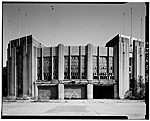The subways may have been dirtier during the 70s, with graffiti everywhere, both inside and outside the cars. But there were also several lines back then which were useful but no longer run. Here are a few:
The Bowling Green/South Ferry Shuttle on the 4 and 5 lines. Walk to the far southern end of the Bowling Green Station and you will see a small, unused train platform from which a short shuttle train ran to South Ferry. The Shuttle utilized the same station at South Ferry as the #1 line. It was a fascinating double loop, with the Shuttle stopping on the inner track of the loop, and the #1 on the outer.
The Aqueduct SpecialOn the platforms at the 42 Street stop on the IND A, C and E lines are several staircases, now closed off. These lead to a lower level from which you could board special trains that went to Aqueduct Race Track in Queens. It’s a pretty long ride to “The Big A” via the A train, so this train must have been popular with racing fans.
“The Train to the Plane”NYC has never come up with a good way to get from Manhattan to JFK Airport in Queens. But during the 70s the TA ran a special “JFK Express” which ran from 57 Street on the 6th Avenue line to the Howard Beach station, where you could get a shuttle bus to the airport. The JFK Express ran frequently; had no graffiti; utilized the most modern cars in the TA fleet, and had a cop on board each train. For this, the MTA believed, passengers would gladly pay an additional fare on board the train; I believe it was $3. Unfortunately, despite a heavy promotional campaign, the Express was a flop. Hardly anybody used it, and most who did were airport employees, and not travelers.
The EE and KK LinesUp through the 70s the TA used double letters to designate local lines, and single letters for expresses. For example, the R train, which has always been a local, was the RR, and the L line the LL. The EE line ran part-time from the middle track at the Whitehall Street station on the Broadway line, through Queens, terminating at 71/Continental Avenue. This was distinct from the regular E, which at the time went from Rockaway to 71/Continental, with express service in Queens. The KK also ran part-time, from 57 Street on the 6th Avenue line down to Broadway/Lafayette, where it switched to the F tracks under Houston Street, and then switched again to the J tracks over the Williamsburg Bridge. From there it crept along the ancient Broadway (Brooklyn) elevated line to its terminus at the Eastern Parkway/Broadway Junction station in East New York. Since the KK was discontinued, no train has ran from Uptown and then over the Williamsburg Bridge to Brooklyn.
The QB and QJ TrainsThe different letter combinations were a real oddity. Q apparently designated the Brighton line in Brooklyn. QB trains ran over the Brighton Line in Brooklyn, but then followed the B (6 Avenue) route in Manhattan. The QJ, which was discontinued in the early 70s, followed the Brighton line in Brooklyn, and then the J route back into Brooklyn via the Williamsburg Bridge, all the way out to the terminus in Queens. This was a long stretch for any motorman.
The Culver ShuttleGet off at the 9 Avenue (Brooklyn) stop on the B line, which is actually in the midst of a train yard, and you will find stairs leading to a lower platform. From there the Culver Shuttle would rise from the train yard and then became an elevated line, passing the edge of Greenwood Cemetery over a private right of way on which freight trains could travel. After making a few stops in Borough Park the Shuttle tracks joined those of the regular Culver Line – the route of the F train, at Ditmas Avenue. The entire elevated line over which the Shuttle passed has since been demolished.
The Lost Stations on the J TrainThe Jamaica Avenue “EL” may be slow, but it’s great for subway fans who want a taste of what the really old elevated lines were like. Into the early 70s the J train ran all the way to 168 Street, at the tail end of what was at the time a thriving commercial strip. Perhaps hoping that ripping down the portion of the J train which ran over the Jamaica Avenue merchant strip might help the faltering economy of the community, the TA in their infinite wisdom closed all stations East of 121 Street in Richmond Hill. Eventually, after the usual years of delays, they brought the J train back underground after that stop and ran it in a new tunnel under Archer Avenue to “Jamaica Center,” where it shares a terminus with the E train.
Alas, like much of the urban planning of the era, this did no good for the economy of downtown Jamaica, which continued to tank.

